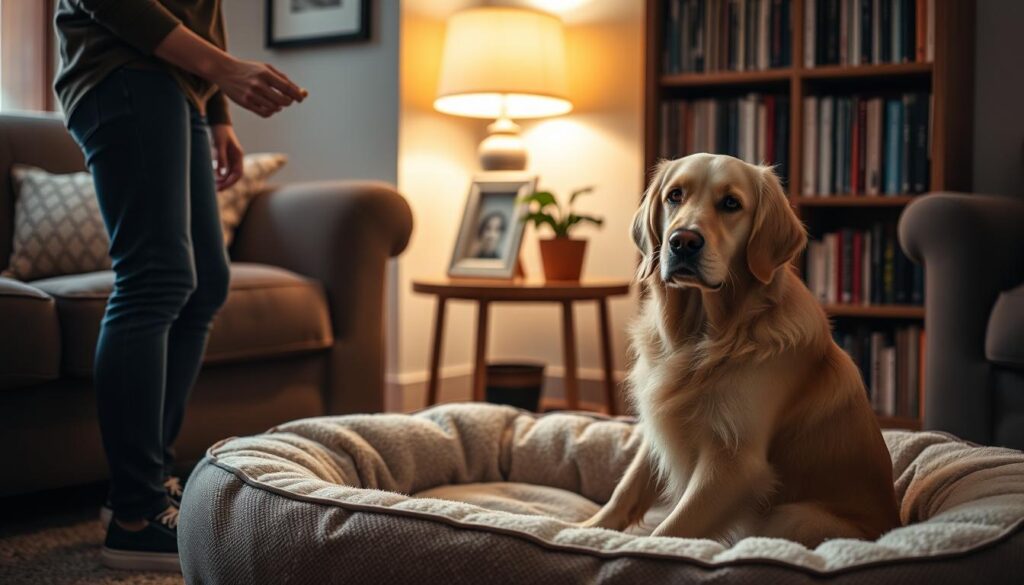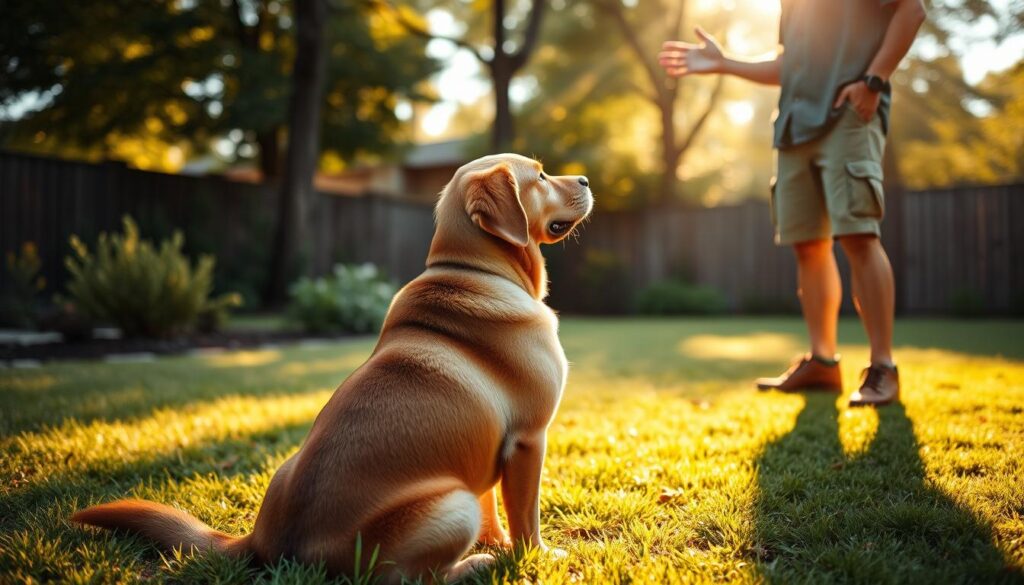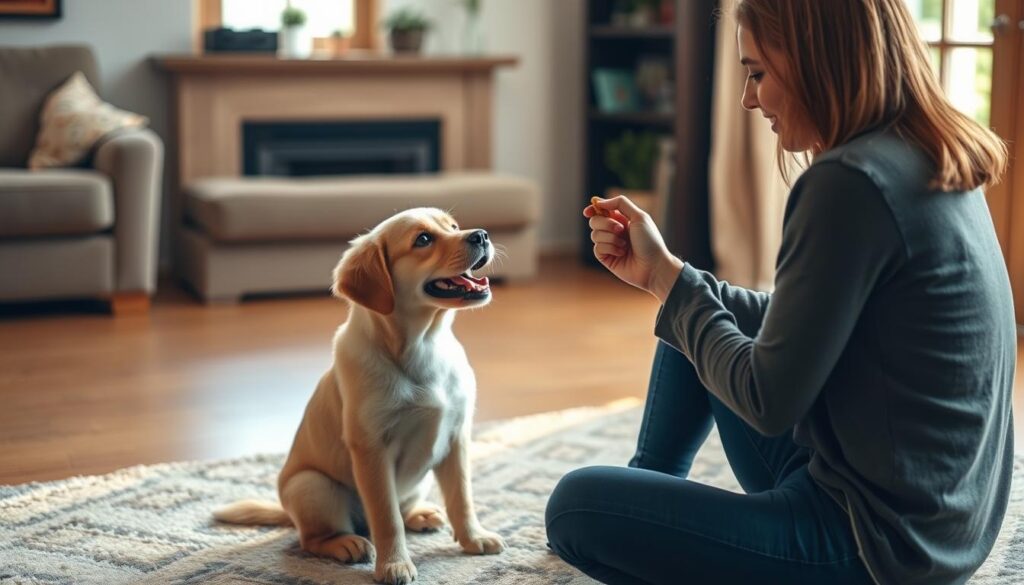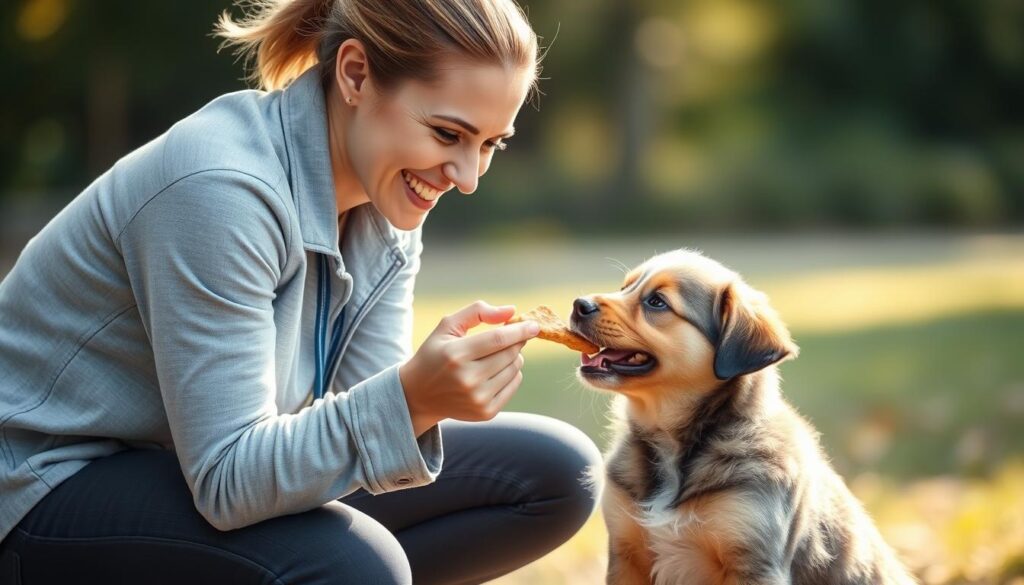Can you change your dog’s behavior in just ten days? Yes, you can with our 10-day dog training plan. This guide is your step-by-step to teaching your dog new tricks and improving their obedience. It’s perfect for both new and experienced dog owners.
Our comprehensive dog training guide is here to help you see quick and effective results. You’ll learn how to teach your dog in 10 days with fun, short, and consistent daily exercises.
Key Takeaways
- Transform your dog’s behavior in just ten days with our structured plan.
- Daily short and fun training exercises lead to significant progress.
- Improve basic obedience and master new tricks.
- Enhance the bond between you and your dog through consistent training.
- Receive clear, expert guidance every step of the way.
Introduction to the 10-Day Dog Training Plan
Welcome to the start of an exciting journey with your furry friend. Our 10-Day Dog Training Plan aims to change your dog’s behavior and strengthen your bond. This dog training program covers both basic and fun aspects. You’ll find our effective dog training tips easy to follow and quick to show results.
For the next ten days, you’ll follow a structured plan that’s easy and rewarding. Each day, you’ll do specific activities that focus on important commands and fun tricks. We know life can be busy, so our plan fits into your schedule with just ten minutes a day. This approach makes training easy and keeps your dog interested.
Our puppy training guide makes each day’s task simple yet effective. You’ll learn everything from “sit” and “stay” to cool tricks. It’s like having short, fun bonding sessions that help your dog behave well and be happy.
By using this dog training program, you’re laying the groundwork for a lifetime of good behavior and understanding. Let’s start these ten days and make them a special time for you and your pup!
Day 1: Establishing the Basics with Sit and Stay
Starting your puppy obedience training with “sit” and “stay” is key. These basic dog commands are vital for a well-behaved pup. They help control your dog in many situations, keeping them safe and you calm. Let’s start with these essential skills.
How to Teach Your Dog to Sit
Teaching your dog to sit is easy yet powerful. Here’s how to do it:
- Hold a treat close to your dog’s nose.
- Slowly raise your hand, letting their head follow the treat. This will make their bottom lower.
- When they sit, say “sit” and give them the treat, praising them.
Do this several times a day. It’s part of your training schedule for dogs. Being consistent helps your dog learn and follow the command.
How to Teach Your Dog to Stay
After your dog learns “sit,” it’s time for “stay”:
- Have your dog sit in front of you.
- Hold out your hand, palm facing them, and say “stay.”
- Step back. If they stay, reward them with a treat and praise.
- If they move, gently guide them back and repeat the command.
Practice every day to strengthen the behavior. Adding “stay” to your training schedule for dogs keeps them disciplined in different places.
Day 2: Building Trust and Recall
On the second day of our 10-Day Dog Training Plan, we focus on building trust and improving recall commands. It’s important for your dog to listen to you, even when there are distractions. Positive reinforcement makes training fun and effective for your dog.
Using Positive Reinforcement Techniques
Positive reinforcement is key to teaching your dog good habits. Reward them with treats, praise, or playtime when they obey. Verbal praise and a friendly tone also help build trust.
Begin recall training in a quiet place with few distractions. As your dog gets better, add more distractions. Always use the same command word and keep your tone friendly.
Recall Training Tips
Keep recall training sessions short and fun. Here are some tips to help you:
- Always have your dog on a leash or in a fenced area when practicing recall commands for dogs.
- If your dog doesn’t respond immediately, don’t use a harsh tone. Instead, call them by name and show a treat or toy to grab their attention.
- As soon as your dog begins to come towards you, continue praising them to build excitement and positive association.
The goal is to make coming to you the most exciting thing for your dog. By using positive reinforcement and effective training techniques, you create a positive learning environment for both you and your dog.
Day 3: Teaching Your Dog to Leave It
Teaching your dog the “leave it” command is key for dog behavior modification. It keeps your pet safe and you at ease. It stops them from picking up harmful things or touching items you don’t want them to.
First, get some treats and a distraction your dog likes but can’t have. Start by giving your dog a treat and letting them sniff it. Then say, *”leave it,”* as you cover the treat with your hand. Wait for your dog to lose interest and look away. Then, praise them and give a different treat from your other hand.
This training needs patience and consistency. As your dog gets better, use more interesting distractions and harder scenarios. Always reward your dog when they do the “leave it” command right.
In a pet obedience course, you can make this command even stronger. Group classes are great because they offer many distractions. This helps your dog learn the command in different situations. Remember, the secret to success is being consistent and positive. Keep practicing, and your dog will learn the “leave it” command well.
Day 4: Introducing Down Command
Teaching your dog the ‘down’ command is key in obedience training. It helps them be calm and follow your lead. Learning to lie down on command is a big step in their training. It also helps manage their behavior in different situations.
Steps to Teach Down Command
- Start with your dog in a sitting position.
- Hold a treat close to their nose to get their attention.
- Slowly move the treat down towards the ground, guiding their nose.
- When they lie down, give them the treat and praise them right away.
- Keep repeating these steps, linking the action with the command “down.”
Common Mistakes to Avoid
When teaching the ‘down’ command, watch out for these common mistakes:
- Inconsistent Commands: Always use the same word for the command.
- Improper Timing of Rewards: Give rewards right after they do what you want to make the connection strong.
- Skipping Steps: Training takes time. Skipping steps can confuse your dog and slow them down.
Avoid these mistakes and follow these tips to teach your dog the down command well.
Day 5: Training Your Dog to Go to Their Place
On Day 5 of our dog training curriculum, we teach your dog the “place” command. This command is key. It makes your dog go to a spot and stay there until you say it’s okay. This training is great for controlling your dog in many situations.
Benefits of Place Training
Place command training is good for you and your dog. It helps your dog feel safe in loud places. It also makes it easier to keep your dog calm when there are visitors or lots of noise at home.
Steps to Teach Place Command
Here’s how to teach your dog the place command:
- Select a Spot: Pick a spot in your home, like a bed or mat, for your dog to go to.
- Introduce the Command: Take your dog to the spot and say “place.” Give them a treat if they go there.
- Practice Duration: Make your dog stay longer in their place. Use treats and praise to help them.
- Introduce Distractions: Add things that might distract your dog to see if they stay in their place.
- Consistency: Practice this command often. It helps your dog learn and remember.
Be patient and use positive rewards. Place training helps your dog listen now and in the future.

Day 6: Fun Tricks – Shake and High Five
Adding new tricks to your dog’s routine makes training fun. *Shake* and *High Five* are great for both you and your dog. They improve your pet’s coordination and social skills, perfect for any party.
How to Teach Your Dog to Shake Hands
Teaching the shake hands command strengthens your bond and boosts obedience. Here’s a simple guide:
- Start with your dog sitting.
- Hold a treat in your closed hand.
- Let your dog sniff your hand; they’ll likely lift their paw.
- Once the paw is lifted, say “Shake” and gently take their paw.
- Reward with the treat and lots of praise immediately.
Practice these steps a few times a day. Soon, your dog will learn the shake hands command.
Teaching the High Five Command
Teaching the high five trick is easy after your dog learns to shake. Follow these steps:
- Have your dog start in the sitting position.
- Hold a treat between your fingers, encouraging your dog to reach for it with their paw.
- As your dog lifts their paw, say “High Five” and give them the command with your hand in a high-five position.
- When their paw touches your hand, reward them with the treat and verbal praise.
Keep training sessions short and fun. This keeps your dog interested and excited to learn more.
Day 7: Practicing Backup Command
Welcome to Day 7 of our 10-Day Dog Training Plan! Today, we’ll learn the back up command. It’s a key skill for advanced dog training, useful in many situations.

Begin by standing in front of your dog. Hold a treat to lure their nose towards you while you step closer. This encourages them to step back. Reward them with the treat and praise as soon as they do.
This way, your dog will learn to associate the action with the reward. Remember, consistency is vital in dog training.
Now, add a verbal cue like “back up”. Repeat the steps with the treat and the command. Be patient and reward your dog as they step back. This helps them connect the command with the action.
It might take a few sessions for your dog to get it. Practice in short, frequent sessions. The back up command is not just useful. It also strengthens your bond with your dog.
Day 8: Introducing Bow and Spin
Today, we’re adding some flair to your dog’s tricks with ‘bow’ and ‘spin’ commands. These tricks are not only fun to watch but also keep your dog’s mind sharp. Let’s explore these activities and how to do them step by step.
Teaching the Bow Command
To teach your dog to bow, start with them standing. Hold a treat near their nose and slowly move it down. Move it towards their chest.
As they lower their front elbows, their rear end will stay up. Praise them and give the treat when they do this. Keep practicing until they bow on command.
Steps to Teach Your Dog to Spin
The spin trick for dogs is a fun command. Start by holding a treat near their nose. Guide them in a circle with the treat, saying the spin command.
When they finish the circle, praise them and give the treat. With practice, they’ll learn to spin on command.
Day 9: Advanced Commands – Speak and Quiet
Today, we’re exploring advanced dog obedience with “speak” and “quiet” commands. These skills will impress your friends and help you control your dog’s barking. They improve communication and ensure your dog behaves well in social situations.

How to Teach Your Dog to Speak
To teach your dog to speak, catch them when they bark naturally. Use a hand signal and say “speak.” Give them a treat right away to make them associate the action with the reward.
- Get your dog excited, like knocking on the door or showing a favorite toy.
- When they bark, say “speak” and use a hand signal at the same time.
- Give them a treat right away to reinforce the action.
Be consistent. Practice a few times a day, keeping it short to keep your dog interested.
Training Your Dog to Be Quiet
After your dog learns “speak,” it’s time for the quiet command. This command helps stop unwanted barking and keeps your home peaceful.
- When your dog barks, say “quiet” calmly but firmly.
- If they stop, reward them with a treat and praise.
- If they keep barking, don’t reward. Instead, use a gentle correction like turning away or ending the session.
Positive reinforcement helps your dog learn better. Avoid yelling or showing frustration, as it can confuse them. With patience, your dog will learn to be quiet.
Learning these advanced commands will change your daily life and social interactions. Keep practicing, and you’ll see big improvements in your dog’s behavior.
Creating a Daily Routine for Your Dog
Creating a daily routine for your dog is key for good training and positive behavior. A consistent dog training routine makes a structured home, good for you and your dog.
Importance of Consistency
Consistency is vital in dog training. A consistent dog training schedule teaches discipline and reinforces training. Dogs love routine, and a regular effective training routine reduces confusion and bad behavior.
Sample Daily Training Schedule
Here’s a sample daily dog training schedule with various exercises and commands:
- Morning: Teach Sit, Stay, and Down for 10-15 minutes.
- Midday: Learn fun tricks like Shake or High Five for 10 minutes.
- Afternoon: Practice Recall and Leave It for 10-15 minutes.
- Evening: Do advanced commands or obedience training for 10-15 minutes.
This routine gives your dog a balanced training experience. The secret to success is sticking to an effective training routine your dog can count on.
Using Positive Reinforcement Methods for Effective Training
Positive reinforcement training is a kind and effective way to train dogs. It rewards your dog for good behavior, making training fun for both of you.

Rewards-based training is a big part of positive reinforcement. Rewards can be treats, praise, or playtime. By rewarding good behavior, your dog learns to do it again.
To motivate your dog, follow these tips:
- Choose the Right Rewards: Dogs like different things. Some like treats, others affection or toys.
- Timing is Crucial: Reward your dog right after they do something good. This helps them connect the action with the reward.
- Consistency is Key: Stick to your training and rewards. This avoids confusing your dog.
Positive reinforcement training boosts your dog’s mood and mind. It builds trust and strengthens your bond. It also reduces bad behavior, making your pet happier and well-adjusted.
Using rewards-based training and motivational training for dogs makes learning fun. Your dog will be excited to learn and do new things, making training a joy.
Common Challenges and How to Overcome Them
Training your dog can sometimes bring about various difficulties. Understanding how to address and rectify these challenges is key for successful dog training.
Difficult Behaviors During Training
Dealing with dog behavior issues like excessive barking, chewing, or not following commands is tough. It’s important to use consistent training methods. Find out what triggers these behaviors in your dog and adjust your training approach.
Using positive reinforcement and patience can help overcome these challenges. This approach will make training easier for both you and your dog.
How to Stay Patient and Consistent
Staying consistent in training is vital for long-term success. Create a training routine and stick to it. Make sure to train at the same time every day.
Setting up predictable training and reward systems helps. It fosters better behavior and strengthens your bond with your dog.
Remember, patience is essential when dealing with dog behavior. Stay calm and supportive, even when things don’t go as planned. Consistency in training leads to the best results.
Importance of Socialization in Dog Training
Learning about socialization in dog training can greatly affect your pet’s behavior and your experience as a dog owner. Using dog socialization techniques helps raise a confident and well-behaved dog.
Socializing puppies early is key. It lays the groundwork for their behavior and gets them used to different places, people, and animals. Without it, dogs might get anxious and have behavioral problems that are hard to fix later.
One big plus of socialization is it boosts your dog’s confidence. When they’re comfortable in many places, they feel less stressed and are more flexible. This flexibility is essential for their training, as it lets them learn commands even when there’s a lot going on.
Also, introducing your dog to new things helps lower their anxiety. By using dog socialization techniques, you help them get used to different sounds, sights, and situations. This way, they’re less likely to freak out when they see or hear something new.
In short, spending time on socializing puppies and adding these methods to your training plan is very rewarding. It improves their ability to handle new places and turns them into friendly, well-adjusted pets that are a pleasure to have around.
Conclusion
Reaching the end of your 10-day dog training plan is a big achievement. You’ve taught your dog new tricks and encouraged good behavior. Your hard work has shown, and your dog has likely improved a lot.
Keep up the good work to keep your dog’s progress going. The journey to better dog training doesn’t end here. Keep practicing the commands and tricks you’ve learned. Add new challenges to keep your dog’s mind sharp.
Remember, training is a long-term commitment. The progress you’ve seen is just the start. Enjoy the journey of having a well-trained, happy dog. Your hard work and patience will make your life with your dog better and more fun.
